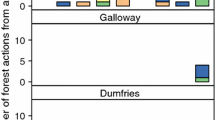Abstract
Climate forecast information needs of forest managers are based on issues and problems of forest management and related ecosystem management. In order to provide quality service to forest managers, it is essential to identify and understand those issues and problems which require meteorological or climatological information. Knowing how the information is used is crucial to providing a quality service for effective forest management. As problems and issues (Fosberg 1987, 1990), we mostly consider catastrophes such as forest fires, wind storms and floods; climate change; chronic air pollution threats; insect and disease outbreaks; and for example issues like economic development of forest resources and preservation of ecosystems. Each has its own meteorological and climatological forecast needs at particular time and space scales.
Access this chapter
Tax calculation will be finalised at checkout
Purchases are for personal use only
Preview
Unable to display preview. Download preview PDF.
Similar content being viewed by others
References
Bachelet D, Neilson RP, Leniham JM, Drapek RJ (2001) Climate change effects on vegetation distribution and carbon in the United States. Ecosyst 4:164–185
Bernabo JC, Ellington DD (1992) Joint climate project to address decision makers’ uncertainties. Report No. TR-100772. Electric Power Research Institute, Pleasant Hill, California, 86pp
Betancourt JL, Pierson EA, Rylander KA, Fairchild-Parks JA, Dean JS (1993) Influence of history and climate on New Mexico Pinyon-Juniper woodlands. In: Aldon EF, Shaw DW (eds), Managing Pinyon-Juniper ecosystems for sustainability and social needs. USDA Forest Service, Rock Mountain Forest and Rangeland Experiment Station, Gen. Tech. Rep. RM-236, Fort Collins, Colorado, pp 42–62
Brady AB, de Groot WJ, Goldammer JG, Keenan T, Lynham TJ, Justice CO, Csiszar IA, O’Laughlin K (2007) Developing a global early warning system for wildland fire. In: Sivakumar MVK, Motha RP (eds) Managing weather and climate risks in Agriculture. Springer, Berlin/Heidelberg/New York pp 355–375
Cooper W (1994) Risk assessment requirements. Arct Res 8:112–115
Das HP (2004) Satellite-based agro-advisory service. In: Sivakumar MVK, Roy PS, Harmsen K, Saha SK (eds) Satellite remote sensing and GIS applications in agricultural meteorology. AGM-8, WMO/TD 1182, Geneva, pp 347–360
Das HP (2005) Agrometeorological impact assessment of natural disasters and extreme events and agricultural strategies adopted in areas with high weather risks. In: Sivakumar MVK, Motha RP, Das HP (eds) Natural disasters and extreme events in agriculture. Springer, Berlin/Heidelberg, pp 93–118
Fosberg MA (1987) Forest forecasting. Proceedings of the Conference on Wildland Fire 2000, University of California Press, Berkeley, pp 105–114
Fosberg MA (1990) Global change – a challenge to modeling. In: Dixon R (ed) Forest growth: process modeling of response to environmental stress. Timber Press, Portland, pp 3–7
Fosberg MA (1995) Meteorological needs for temperate and boreal forest management. CAgM Report No. 64, WMO/TD 728, Geneva, pp 1–13
Fosberg MA, Stock BJ (1992) Global change and boreal forest ecosystems. American Society of photogrammetry and remote sensing, Vol. 5. Resource Technology, pp 164–176
Fosberg MA, Mearns LO, Price C (1992) Climate change-fire interactions at the global scale: predictions and limitations of methods. In: Crutzen P, Goldammer JG (eds) Dahlem conference of fire in the environment: The ecological, climatic and chemical importance of burning in wildland and rural landscapes. Wiley, New York, etc, pp 345–356
Fosberg MA, Stock BJ, Lynham TJ (1996) Risk analysis in strategic planning: fire and climate change in the boreal forest. In: Goldammer JG, Furyaev VV (eds) Fire in ecosystems of boreal Eurasia. Forestry Sciences, Vol. 48. Kluwer, Dordrecht, etc, pp 494–505
Motha RP (2001) Agrometeorological bulletins – how can we improve them? Proceedings of the Inter-Region Workshop, Bridgetown, pp 13–24
Nepstad DC, Lefebvre PA, da Silva ED, Tomasella J, Schlesinger P, Solorzano L, Moutinho P, Ray D, Banito JG (2004) Amazon drought and its application for forest flammability and tree growth: a basin-wide analysis. Glob Change Biol 10:704–717
Nunez L (2005) Tools for forecasting or warning as well as hazard assessment to reduce impact of natural disasters on agriculture, forestry and fisheries. In: Sivakumar MVK, Motha RP, Das HP (eds) Natural disasters and extreme events in agriculture. Springer, Berlin, etc, pp 71–92
Qu J, Wolf H (2003) Wildfire behaviour science and modeling strategic planning. Presentation for USDA/FS R&D, National fire plan, January 16–17, New Orleans, 20pp
Riebau AR, Qu JJ (2005) Application of remote sensing and GIS for analysis of forest fire risk and assessment of forest degradation. In: Sivakumar MVK, Motha RP, Das HP (eds) Natural disasters and extreme events in agriculture. Springer, Berlin/Heidelberg, pp 335–350
Roy PS (2004) Forest fire and degradation assessment using satellite remote sensing and geographic information systems. In: Sivakumar MVK, Roy PS, Harmsen K, Saha SK (eds) Satellite remote sensing and GIS applications in agricultural meteorology. AGM-8, WMO/TD 1182, Geneva, pp 361–400
Stefanski R (2004) Impact of agrometeorological applications for sustainable management of forestry. In: The impacts of agrometeorological applications for sustainable management of farming, forestry and livestock systems. CAgM Report 92, WMO/TD 1175, Geneva, pp 29–55
Author information
Authors and Affiliations
Corresponding author
Editor information
Editors and Affiliations
Rights and permissions
Copyright information
© 2010 Springer-Verlag Berlin Heidelberg
About this chapter
Cite this chapter
Das, H. (2010). Improving the Issuing, Absorption and Use of Climate Forecast Information in Forestry. In: Stigter, K. (eds) Applied Agrometeorology. Springer, Berlin, Heidelberg. https://doi.org/10.1007/978-3-540-74698-0_54
Download citation
DOI: https://doi.org/10.1007/978-3-540-74698-0_54
Published:
Publisher Name: Springer, Berlin, Heidelberg
Print ISBN: 978-3-540-74697-3
Online ISBN: 978-3-540-74698-0
eBook Packages: Earth and Environmental ScienceEarth and Environmental Science (R0)




